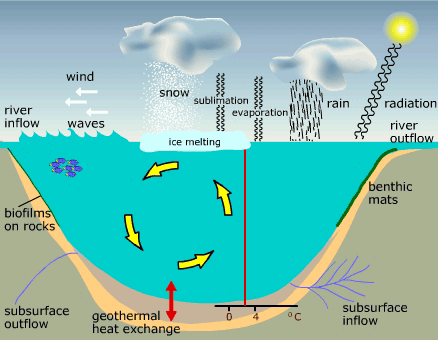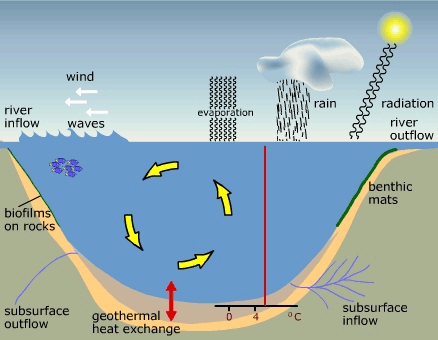 |
|
|
|
|
|
|
The heat budget of a lake is expressed by the different water temperature at different depths. High mountain lakes, like other likes, undergo changes which are governed by seasonal variations in the atmosphere. Organisms have to be able to cope with these changes. The main reasons for the thermal behavior are:
|
|
|
Winter During winter, water temperature below the ice is 0°C. This creates a density inversion (0°C water is lighter than 4°C water) which stratifies the water body during winter. The hypolimnion can become anoxic, nutrients are mobilized in the sediment and build up in the deep water layers. |
1 - Stratification and density inversion during winter |
Spring, after ice has melted Strong winds, lowered surface temperatures (= higher density and viscosity) and the absence of a thermal stratification allow complete mixing of the entire water body. Mixing brings up nutrients from the lake bottom. Anaerobic conditions in lower depths are changed to aerobic ones. |
2 - Spring shows an absence of thermal stratification |
Summer Increased solar radiation heats up the uppermost water layers, which lowers water density and viscosity. The lake becomes stratified and establishes an epilimnion (upper portion of water column) and a hypolimnion (deep portion of the water column). The epilimnion is separated from the hypolimnion through the metalimnion at the thermocline (region of largest temperature changes). The steep temperature gradient from epi- to hypolimnion prevents mixing of the two layers. Algae may bloom where light is abundant. Decomposition of dead algea by bacteria during summer stagnation may result in anoxic conditions at the lake bottom water and in surface sediment layers (increased oxygen consumption). In many alpine zones, cold weather and snowfall events regularly even in summer, which may lead to mixing of the water column at least to a certain depth. |
3 - Summer stratification of lake temperatures |
Fall Winds, colder surface water, and the absence of thermal stratification, allow mixing of the lake. In high mountain lakes, which are normally not deep, mixing can affect the entire water column. Mixing the water column before freezing brings back aerobic conditions and distributes sediment borne nutrients in the entire water column. |
4 - Fall again shows an absence of thermal stratification |
|
Examples of thermal stratification in an alpine lake Below, seasonal changes of the thermal stratification in lake Jöri III are shown (data from Gabathuler 1999). |
Observe changes in the temperature profile by pressing the "play" button.
Try to answer these questions before looking at the informative text. |
|
|
A longterm observation (9 months): |
|
|
How can a cold front in summer add to the heat budget of a lake? Look at the animation below to find the answer. |
|
|
29 August 2011 |
||
| |
||



